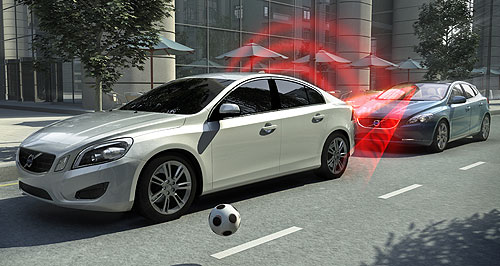News - General News - SafetyMixed results for crash-avoidance techRound the bend: Adaptive headlights have proved effective at reducing US car insurance claims. US insurance study reveals not all crash-avoidance technologies reduce crashes6 Jul 2012 ANALYSIS of United States car insurance claim data by the US Highway Loss Data Institute has revealed the real-world benefits of hi-tech, safety-boosting driver aids – and those that appear to cause rather than prevent crashes. The best results were recorded by autonomous braking systems, which use radar or cameras to predict collisions and automatically apply the brakes if there is no response from the driver, and adaptive headlights, which focus the beam in the direction of steering. Lane-departure warning was found to have the opposite effect – although HLDI is not sure why – while not enough data is yet available on vehicles fitted with blind-spot monitoring and parking assistance systems. The results of the study come less than a month after Euro NCAP announced it will start including autonomous braking in its star ratings from 2014 to encourage more manufacturers to fit it as standard. ENCAP says real-world performance data suggests autonomous braking can reduce crashes by up to 27 per cent, while HLDI data showed systems fitted to Acura (Honda’s premium brand) and Mercedes-Benz vehicles reduced crashes by 14 per cent and Volvo’s system by 10 per cent. HLDI – a division of the Insurance Institute for Highway Safety – recorded a lower frequency of insurance claims for third-party property damage on cars with autonomous braking.  Left: Ford's lane departure system. Left: Ford's lane departure system.HLDI points out that, while systems that warn the driver but do not automatically brake appear to reduce crash rates, the effect on insurance claims is smaller because there is still a reliance on the driver to respond. The organisation also notes that Volvo’s warning-only system kicks in at 32km/h, but starts working from 5km/h when combined with autonomous braking. HLDI was surprised at the apparent effectiveness of adaptive headlights on Acura, Mazda, Mercedes and Volvo vehicles, which reduced property damage claims by up to 10 per cent. Seven per cent of police-reported crashes in the US happen between 9pm and 6am and involve more than one vehicle, but data showed fewer claims for third-party property damage than for the insured vehicle, whereas analysts expected a larger reduction in single-vehicle crashes. The higher than expected safety improvements attributed to adaptive headlights could be that, in addition to their ability to angle the beam, the systems are often part of a premium lighting package with increased brightness or range. However, HLDI said the differences were not consistent across all vehicles in the analysis. Claims for vehicles with lane-departure warning systems were analysed for vehicles from Buick, Mercedes and Volvo, with the surprising revelation that for Buick and Mercedes, claims for third-party property damage, damage to the insured vehicle and occupant injuries were higher. Statistics showing lower claims for Volvos fitted with the technology could be skewed because it comes bundled with autonomous braking. HLDI concedes that a lack of benefits in the data for lane-departure could be due to drifting off the road not being common, but says problems with the technology’s effectiveness or drivers disabling it due to false alarms could also be a factor. Systems that work with the vehicle’s steering to keep a vehicle in its lane were not included in the study and the HLDI says that these could have a different impact on claims. IIHS chief research officer David Zuby pointed out the higher effectiveness of autonomous braking systems compared with ones that simply warned the driver could also be true of lane-departure technology. “Lane-departure prevention systems that don’t rely on a driver’s response may hold more promise than the systems HLDI has looked at so far,” he said. “The lane-departure prevention systems are newer and less common than the warning systems, so we’ll have to wait for more data before we can look for a pattern there.” Claims data for vehicle model years from 2000 to 2011 were analysed, depending on when the manufacturer introduced the technologies assessed. Data controls were put in place for factors potentially affecting claim rates, such as driver age and gender, state of registration and level of insurance excess. Mr Zuby said the HLDI study is “the first to estimate real-world effectiveness of several crash avoidance technologies that have been filtering into the market recently”. “While some results indicate the need for further investigation, it’s clear that certain systems – such as those that help drivers avoid collisions with the vehicle in front or better illuminate the road ahead – can play a role in making roads safer for everyone.” Australasian crash safety authority ANCAP will make ‘safety assistance technologies’ mandatory for a five-star rating from next year and provides manufacturers with a list of eligible systems – although this includes basic additions such as daytime-running lights and head restraints for all seats. In addition, the Australian government is considering making more vehicle safety technologies mandatory, such as electronic stability control for light commercial vehicles, brake-assist for passenger cars and anti-lock brakes for motorcycles. Introducing mandatory ABS, lane-departure warning and advance emergency braking for heavy trucks is also under consideration.  Read more3rd of July 2012  Government considers more safety legislationFederal legislators consider making more safety tech mandatory as road toll declines20th of June 2012  ANCAP announces tighter tests for 2017Amended roadmap focuses on making low-scoring cars safer as ANCAP tightens for 2017 |
Click to shareGeneral News articlesResearch General News Motor industry news |
















Facebook Twitter Instagram